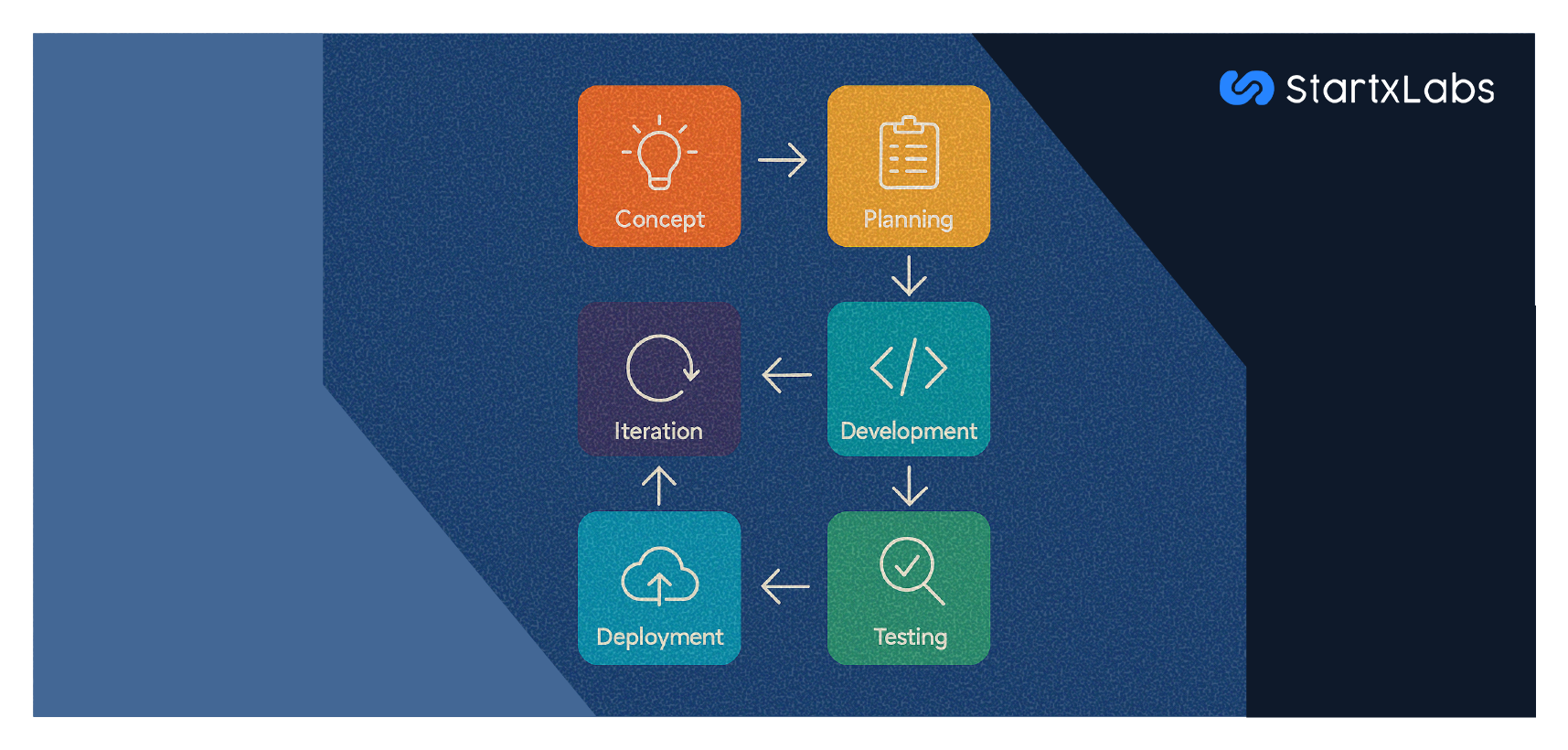software development
Navigating the Software Development Lifecycle: Transforming Concepts into Capabilities

Navigating the Software Development Lifecycle: Transforming Concepts into Capabilities with StartxLabs
In today’s digital landscape, custom software plays an increasingly central role in helping businesses innovate, streamline operations, and improve customer experiences. For many entrepreneurs and business leaders, especially those without a background in software development, getting familiar with the overall process can be highly beneficial. A basic understanding of the software development lifecycle (SDLC) helps set realistic expectations, facilitates clearer communication with development teams, and increases the likelihood of building a solution that aligns with actual business needs.
This article outlines how we at StartxLabs approach software development, explaining each phase of the SDLC from concept to launch and beyond. Whether you're working on a new digital product or aiming to improve internal systems, this overview is meant to help you feel more informed and confident throughout the process.
Our Approach at StartxLabs
At StartxLabs, we don’t see ourselves as just developers; we aim to be collaborative partners in problem-solving. Our role is to take your ideas and business context seriously and to work with you to build software that’s not only functional but also relevant to your specific goals. Many of our clients don’t come from a technical background, and that’s completely fine. We believe that your understanding of your industry, workflows, and customers is just as important as our technical skills.
We make it a point to involve clients at each step, explaining decisions and seeking input regularly. Where appropriate, we also make use of low-code or no-code platforms to quickly prototype ideas and let clients see their concepts in action early. This helps reduce delays and supports more meaningful feedback.
Understanding the Software Development Lifecycle
Software development can sometimes feel like a black box to those outside the tech world. The SDLC helps clarify the process by breaking it into distinct stages. Here’s how we typically navigate this lifecycle with our clients.
1. Conceptualization and Requirements Gathering
Every project begins with understanding what needs to be solved. This step involves identifying the core problem or opportunity, the target users, and the key features the software should include.
We usually start with detailed conversations, asking questions about how your business works, what specific challenges you face, and what success would look like from your perspective. This isn’t just about compiling a list of features—it's about understanding context, constraints, and goals.
For example, when working on Edukhoj, a platform designed for students and educational institutions, the goal was to simplify how leads are captured, organized, and tracked. We worked with the team to clearly understand user journeys, data needs, and communication patterns before starting any technical design. That initial clarity helped build a focused and efficient platform.
2. Planning and System Design
Once the requirements are clear, we move on to planning how the system will work. This includes choosing the right technology stack, outlining how different parts of the system will interact, and planning for scalability, security, and performance.
This stage also involves UI/UX design. We use wireframes and sometimes clickable prototypes to give clients a clear visual idea of how the software will look and feel. You don’t need to be a designer or developer to give valuable feedback at this stage—your perspective as a business user is extremely helpful.
Planning also includes project timelines, resource allocation, and identifying any potential risks. We try to be transparent about what’s achievable within a given budget and timeframe, and we adjust scope or timelines as needed.
For instance, on the Contlo project where we worked with an existing development team to enhance UI components—we had to plan carefully to integrate seamlessly into their architecture and speed up the front-end delivery using React.js without disrupting their sprint structure.
3. Development and Implementation
With the plan in place, we begin writing the actual code. This is typically the most time-intensive phase, but we break the work into small chunks to maintain progress and flexibility.
We follow agile development practices, which means we work in short cycles and share updates frequently. Instead of waiting until the very end to show results, we prefer to involve clients through demos, testing early features, and incorporating ongoing feedback.
When we developed Zinier, a platform designed to improve deskless productivity for field service teams, we worked on building key features like real-time task updates, offline capabilities, and integrations with existing systems. The development process involved releasing features in phases, allowing the client to provide continuous feedback and make adjustments. This iterative process ensured the platform met the client’s specific operational needs and allowed for flexibility to refine the features based on real-world usage.
4. Testing and Quality Assurance
Before software is released, it needs to be tested carefully. Bugs, slow performance, or confusing interfaces can affect how well your software works for users. That’s why we spend time checking functionality, compatibility, and overall user experience.
We use a mix of automated and manual testing, covering different types of tests such as:
-
Functional testing – making sure features do what they’re supposed to.
-
Integration testing – checking that different parts of the system work well together.
-
Usability testing – confirming that users can navigate and use the software easily.
One important part of this phase is User Acceptance Testing (UAT). This is where you or your team use the software and confirm that it meets your needs. It’s a final validation step to ensure that the product is ready to go live.
In the EduKhoj project, an educational platform designed to connect students and educational institutions, we conducted thorough testing across several components to ensure the platform’s reliability and ease of use. During the testing phase, we performed integration testing to verify that various system components, such as student data, course listings, and institution information, worked seamlessly together. We also conducted usability testing, ensuring the interface was intuitive for both students and institutions to navigate. By focusing on these areas, we ensured EduKhoj provided a stable, user-friendly experience, making it easier for students to find the right educational opportunities.
5. Deployment and Launch
After testing is complete and the software has been approved, we move on to deployment. This step puts your software into production so that users can access it.
Deployment varies depending on the type of software. It could mean publishing a mobile app to the App Store or Google Play, deploying a web application to a cloud environment, or releasing an internal tool on a secure server.
We manage the technical setup—provisioning servers or containers, configuring CD/CI pipelines, and securing necessary credentials—and ensure that automated tests and monitoring are in place. We also assist with user onboarding, creating help documentation or walkthroughs, establishing feedback channels, and monitoring early usage to catch any unexpected issues. Some projects benefit from a phased rollout (feature flags, beta groups), while others go live to everyone at once.
For example, on the Contlo project, we helped orchestrate the frontend release of new marketing-automation features. That involved coordinating multiple deploys—demo environments for client previews, staging for internal QA, and production for live use. We set up real-time monitoring dashboards to track feature usage and error rates, and worked closely with Contlo’s team to onboard their marketing users with in-app tips and help articles. This careful, step-by-step approach ensured a smooth launch without disrupting ongoing campaigns.
6. Ongoing Maintenance and Iteration
Launching your software isn’t the end of the journey. As real users begin to interact with the system, feedback surfaces, new requirements emerge, and underlying platforms evolve. Regular updates keep the software reliable, secure, and aligned with your business goals.
We offer ongoing support that includes:
-
Bug fixes for any issues that slip through or arise with new usage patterns
-
Performance optimizations to handle growing traffic or data volumes
-
Feature enhancements driven by user feedback or changing market needs
-
Security patches and dependency updates to protect against vulnerabilities
-
Platform upgrades (e.g., moving from an older framework version to the latest)
For instance, with Amar Ujala, we continued to refine their TV app after initial launch—improving load times, refining navigation menus based on viewer behavior, and adding background-play capabilities in response to user requests. By treating the app as a living product rather than a one-time release, we helped Amar Ujala maintain high engagement and continually deliver new value to their audience.
Final Thoughts
Starting a software development project can seem overwhelming especially if you’re not familiar with the technical side of things. But with the right approach and a collaborative team, the process becomes manageable and productive.
At StartxLabs, we focus on building partnerships with our clients. We don’t expect you to have all the technical answers. What we do expect is your insight into your business, your goals, and your users. Our job is to translate that insight into software that works for you.
We approach projects with realism, flexibility, and an emphasis on communication. No two projects are the same, and we tailor our process to match the scope and complexity of each one. Whether you're just starting out with an idea or ready to develop a mature system, we’re here to guide you through the process step by step.
If you’re thinking about building custom software, we’re happy to talk about how we can help.

Ready to start with us ?